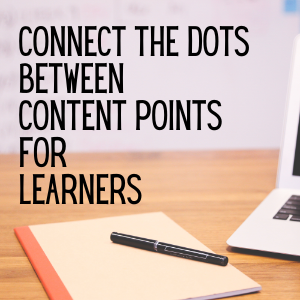How to Go Live: Thinking About Virtual Classroom Facilitation
We all know that organizations have had to quickly move face-to-face training to the virtual classroom. This seismic shift extends beyond...

 A critical element to learning is retrieval practice; the opportunity to revisit and apply new material. Such practice, coupled with meaningful feedback, can help ensure that learners understand material correctly, that they can find it - retrieve it - when needed, even after time has passed, and that they can apply it to real-world situations. Offering meaningful practice opportunities and providing good feedback can also contribute to a sense of social presence, discussed in my last post, Facilitation Tips Series, Part 1: Presence.
A critical element to learning is retrieval practice; the opportunity to revisit and apply new material. Such practice, coupled with meaningful feedback, can help ensure that learners understand material correctly, that they can find it - retrieve it - when needed, even after time has passed, and that they can apply it to real-world situations. Offering meaningful practice opportunities and providing good feedback can also contribute to a sense of social presence, discussed in my last post, Facilitation Tips Series, Part 1: Presence.
What?
Research tells us that feedback on incorrect answers is more effective at improving performance than feedback on correct responses. But here’s the challenge:
The point of instruction is to build gain, not expose inadequacy. In our role of supporting learners, we need to learn to give constructive, helpful feedback that does not embarrass learners. Humiliate them and they may shut down entirely. Newer research discusses the importance of "muting ego needs" in order to help learners learn from errors. While this isn’t always comfortable, it’s a skill that can be learned.
In terms of what’s most effective? Corrective feedback and additional practice:
Not worth much: Practice with no feedback. Not only does this not help, it may reinforce incorrect understanding: In the absence of feedback the learner assumes their understanding is correct.
Ok: Practice with corrective feedback.
Better: Corrective feedback and a chance to try again.
When?
For declarative knowledge delaying feedback for a bit - perhaps until the next day - tends to be more effective than giving it immediately*. We are, after all, working toward helping learners develop skill in long-term retrieval. This can provide additional challenge for the instructor in the virtual classroom, who in seeking to establish presence may otherwise be working to give quick responses to interactions and assignments. Depending on the specifics, if the new learning is skill - or - task-based, it’s usually more effective to let them finish a task than try to offer corrective feedback as they go.
Tip: Watch out for multiple choice type quizzes with “try again” responses. If learners don’t get it by the second attempt then they are probably just guessing. More specific feedback before being offered another try will do more to support new learning.
Another tip about timing: Give people a chance to retrieve the information. The point isn’t just for someone to get the correct answer, but to develop the strategies needed to search for and find it – tomorrow or 3 months from now. Don’t always call on the first person who raises a hand or reveal the quiz answers too quickly.
How?
Tip: Think precision. When possible, go for specific and, if appropriate, quantitative rather than qualitative, feedback. I was once in line at the grocery store behind a mother with a young son. He was mostly just playing at the checkout counter racks of candy and magazines; the mother repeatedly said, “Good job!” to him although I couldn’t figure out what “job” he was supposedly doing. Neither could he. Go for specificity and detail when you can, rather than just “nice try” comments.
Feedback is critical to learning, but you can’t give feedback if people haven’t been given opportunities to practice. As designers and facilitators, it’s important that we develop ways of providing practice opportunities, and those opportunities need to go beyond recall of simple information. Quizzes are easy to create and score, but they often shortchange the learning experience. Will Thalheimer offers this example: “Asking restaurant workers to define terminology is counter-productive in helping them to remember how to ensure food safety.”*
**Thalheimer, W. (2008, May). Providing Learners with Feedback—Part 2: Peer-reviewed research compiled for training, education, and e-learning. https://www.worklearning.com/wp-content/uploads/2017/10/Providing_Learners_with_Feedback_Part2_May2008.pdf(Adapted from Subha Ramani & Sharon K. Krackov (2012) Twelve tips for giving feedback effectively in the clinical environment, Medical Teacher, 34:10, 787-791, DOI: 10.3109/0142159X.2012.684916)
Finally: What About the Learners?
In reviewing research about feedback, I noticed that it’s mostly from the instructor point of view - focused on things like timing and spacing and whatnot – just as I did above. What do learners think of it? After all, it has to be received for it to make a difference. I looked around for what learners say and what I found is: They want comments that are usable, detailed, considerate, and personalized to their own interests and work. Feedback needs to be something that is actionable and goal-referenced. The feedback should be understandable (one article said that using terms like torque to explain a baseball swing to a 6-year-old will likely not create a better hitter) and targeted at a few specifics so as not to overwhelm. Remember to provide ample opportunities for retrieval and practice. In giving feedback, think about what will be helpful, what will encourage additional attempts, and what will support successful workplace performance.

We all know that organizations have had to quickly move face-to-face training to the virtual classroom. This seismic shift extends beyond...

Is anyone out there? Hello? Hello? If you have taught online, you know this feeling. You ask for questions or feedback, and get nothing. And you...

Lynette Van Steinburg has been contributing to the InSync Training team as a virtual producer since 2018. In this blog post, she shares some tips to...